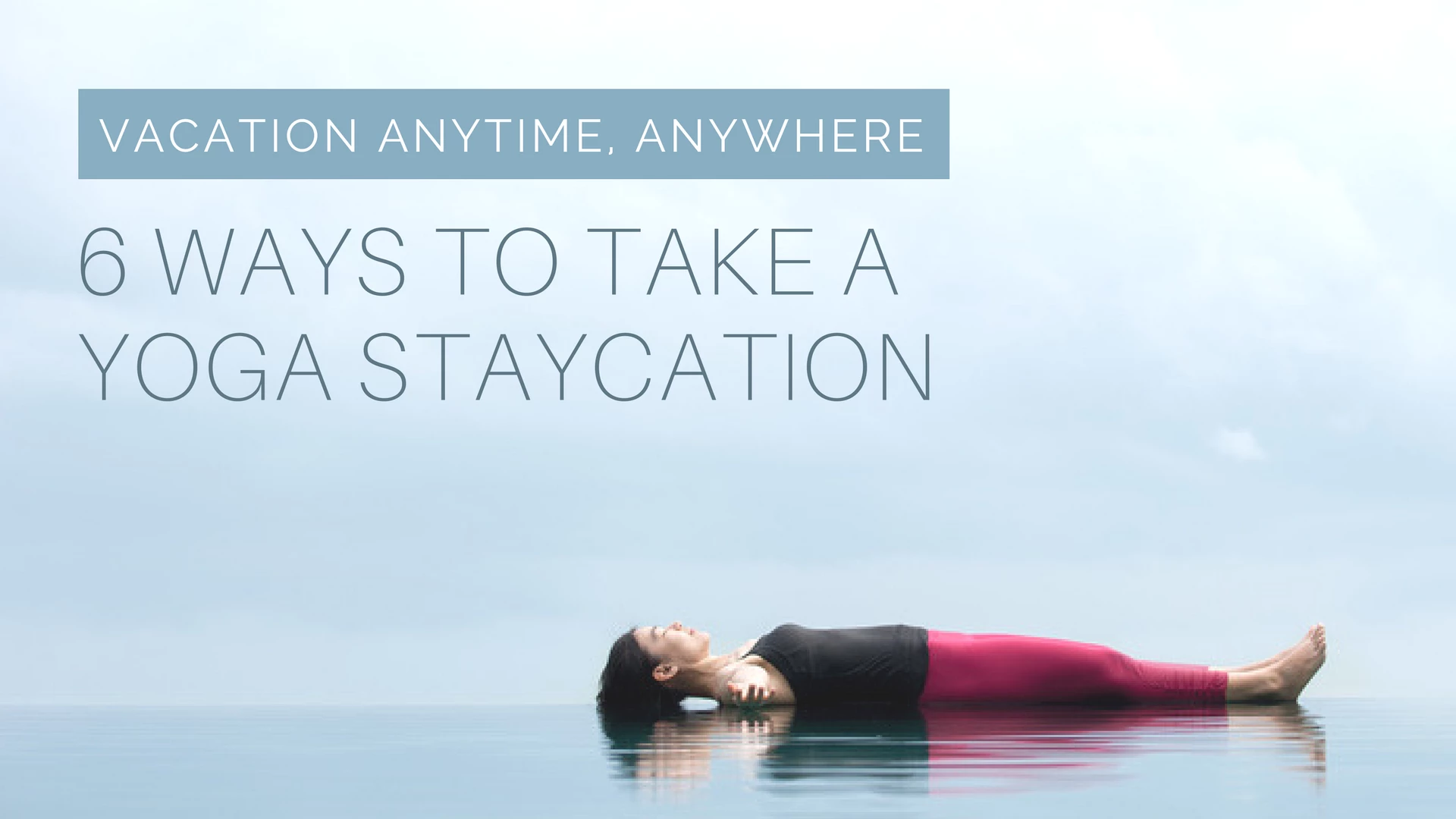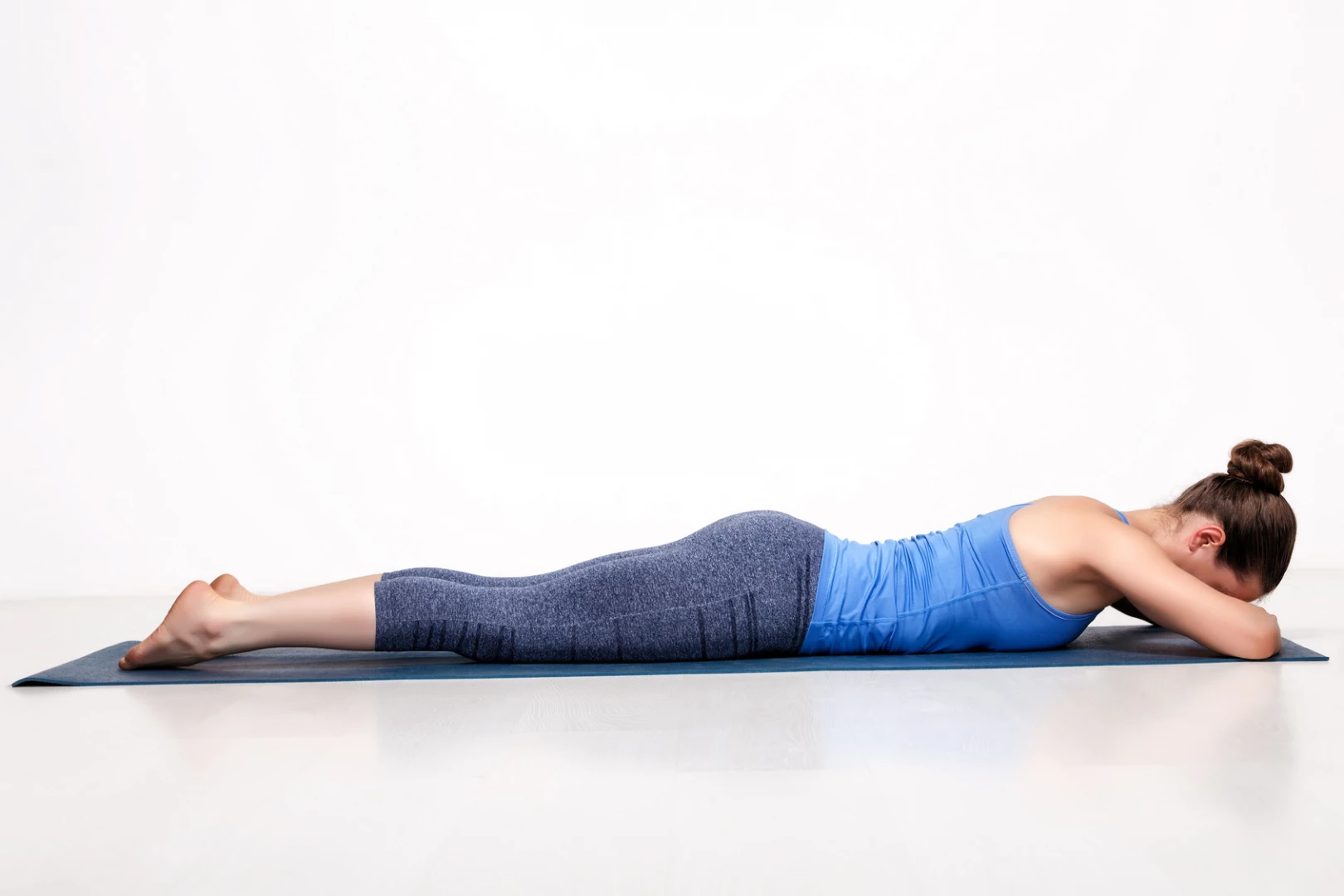Vacation Anytime, Anywhere: 6 Ways to Take A Yoga Staycation

Do you need a vacation from the daily grind but can’t manage to get out of town? Or do you just need a vacation from your regular yoga practice? Or are you actually taking a vacation and wondering how to keep up your asana practice while you’re away? Or maybe you need a vacation after your vacation?
Because it’s the time of year when many of us in the Northern Hemisphere are at least thinking about vacations, if not actually taking them, I thought I’d share some ideas for ways to rest and recharge with yoga. You can use them to create a yoga staycation in your own home or you can take them with you if you leave town to help enhance the “vacation-ness” of your vacation.
1. Explore Savasana (Corpse Pose) 
Although it’s one of the original yoga poses, Savasana tends to get short shrift in modern yoga classes. But this powerful pose allows you to achieve both deep physical and mental relaxation in an anatomically neutral, symmetrical position. What makes this pose so different than just lying down is that Savasana triggers the relaxation response, because you bring your attention to your body and your mind while you lie on the floor instead of just daydreaming or spacing out. And it qualifies as a yoga pose because to practice Savasana properly, you:
-
Align your body
-
Remain still
-
Use a mental focus
-
Maintain your awareness as you come out of the pose
If you don’t practice Savasana regularly at home, try it. If you do practice it but only as an afterthought, try practicing it for a longer time and make sure you practice it as a “pose” rather than just lying down. You can even experiment with having one long Savasana be your entire practice.
2. Practice Restorative Yoga 
Restorative yoga is a form of yoga that was specially designed to provide deep rest and relaxation. In restorative yoga, you use props to support yourself in the shape of a classic yoga pose, including forward bends, backbends, side stretches, twists, (photo to the right) and inversions. For example, in Balasana (Child’s Pose), rather than folding forward all the way onto the floor, you use a bolster or stack of folded blankets to support your entire front body. So restorative yoga is perfect for yoga staycation!
You can add these poses to an active practice (at the end or even the beginning) or practice an entire restorative sequence. Even as little as five minutes in a restorative pose can be beneficial, so be creative with how you weave restorative yoga practice into your day.
3. Practice Supported Inversions 
Supported inverted poses are particularly effective for reducing stress and quieting your mind because these yoga poses use gravity to trigger the relaxation response through the mechanisms that control your blood pressure. You don’t need a mental focus (although you can use one). As long as you are warm, quiet, and comfortable in the pose, all you have to do is let the pose work its magic.
For your yoga staycation, you can add more of these poses to your regular practice or even do a practice focused exclusively on them.
Caution: Not everyone can do supported inverted poses safely. Inverted poses are contraindicated with conditions such as uncontrolled high blood pressure, glaucoma and detached retina.
Inverted poses can include Viparita Karani (Legs Up the Wall Pose), the pose in the above photo; Uttanasana (Standing Forward Bend); Prasarita Padottanasana (Wide-Legged Forward Bend); Halasana (Plow Pose); Sirsasana (Headstand); Sarvangasana (Shoulderstand); and Setu Bandha Sarvangasana (Bridge Pose)—any pose where your head is lower than your heart.
4. Make Any Yoga Practice More Gentle
 Why not treat yourself to a gentle yoga practice now and then? Or maybe even a whole week of gentle practices? If you have a strong home yoga practice, it will be interesting to observe the effects of a gentle practice. And if you don’t yet have a home practice, a gentle practice is the perfect way to start.
Why not treat yourself to a gentle yoga practice now and then? Or maybe even a whole week of gentle practices? If you have a strong home yoga practice, it will be interesting to observe the effects of a gentle practice. And if you don’t yet have a home practice, a gentle practice is the perfect way to start.
Here are some ways to make your yoga practice gentler:
-
For dynamic poses, do fewer repetitions. For example, do three rounds of dynamic Warrior II instead of six.
-
For static poses, use shorter holds, for example, hold Warrior III pose for three breaths instead of six.
-
Extend your time in restorative yoga poses.
-
Leave out the most vigorous pose or poses from the sequence, either skipping them or replacing them with gentle or restorative poses.
-
Between active poses, rest in Savasana (Relaxation Pose) or another resting pose.
Some good resting poses are:
-
Savasana (Relaxation Pose): Practice between supine poses (on your back).
-
Makrasana (Crocodile Pose- see photo above, right): Practice between prone poses (on your belly), such as Salabhasana (Locust Pose) and Bhujangasana (Cobra Pose). Sukhasana (Easy Sitting Pose): Practice between seated poses, such as twists.
-
Tadasana (Mountain Pose): Practice between standing poses.
-
Balasana (Child’s Pose-see photo below, right): Practice after inverted poses and prone poses.
5. Focus on Breathing Practices 
Yoga breathing practices (pranayama) allow you to self-regulate. For your staycation, if you want a quieting or soothing experience, you can add calming breathing practices to your routine. Not all forms of pranayama are relaxing, so it’s important to connect with a teacher who practices and teaches pranayama so that you can choose the practice that’s right for you.
By the way, you don’t have to do these practices sitting up! For your staycation, try them in any restorative pose—Supta Baddhakonasana (Reclined Cobbler’s Pose) and Child’s Pose are good choices—or any gentle inverted pose, such as Legs Up the Wall Pose or Bridge Pose with straight legs. I personally have found extending the exhalation in Legs Up the Wall Pose to be extremely relaxing.
If you have never practiced simple breath awareness, that’s the best place to start.
6. Guided Relaxation and Meditation
Modern guided relaxation practices allow you to achieve both physical relaxation and reduce stress levels by guiding you through a deep physical relaxation experience and providing mental imagery to harness you to the present. These include basic body scans and visualization practices, as well as formal practices such as yoga nidra.
Reprinted with permission from Yoga for Healthy Aging.
Would you like to study Yoga for Healthy Aging? If so study with YogaUOnline and Baxter Bell MD – Yoga for Your Brain – A New Formula for Healthy Aging.
Or enjoy one of our most popular Restorative Yoga Articles – Yoga for a Heavy Heart: 4 Restorative Poses to Soothe Your Heart.
 Nina Zolotow, RYT 500, Editor-in-Chief of the Yoga for Healthy Aging blog, is both a yoga writer and a yoga teacher. She trained to be a yoga teacher at The Yoga Room in Berkeley, California, has studied yoga therapy with Shari Ser and Bonnie Maeda, and is especially influenced by the teachings of Donald Moyer. She also studied extensively with Rodney Yee, and is inspired by the teachings of Patricia Walden on yoga for emotional healing. Her special area of expertise is yoga for emotional well-being (including yoga for stress, insomnia, depression, and anxiety) and she teaches workshops and series classes on yoga for emotional well-being, stress management, better sleep, home practice, and cultivating equanimity. Nina is the co-author with Baxter Bell of Yoga for Healthy Aging: A Guide to Lifelong Well-Being and co-author with Rodney Yee of Yoga: The Poetry of the Body (with its companion 50 Card Practice Deck) and Moving Toward Balance. She is also the author of numerous articles on yoga and alternative medicine.
Nina Zolotow, RYT 500, Editor-in-Chief of the Yoga for Healthy Aging blog, is both a yoga writer and a yoga teacher. She trained to be a yoga teacher at The Yoga Room in Berkeley, California, has studied yoga therapy with Shari Ser and Bonnie Maeda, and is especially influenced by the teachings of Donald Moyer. She also studied extensively with Rodney Yee, and is inspired by the teachings of Patricia Walden on yoga for emotional healing. Her special area of expertise is yoga for emotional well-being (including yoga for stress, insomnia, depression, and anxiety) and she teaches workshops and series classes on yoga for emotional well-being, stress management, better sleep, home practice, and cultivating equanimity. Nina is the co-author with Baxter Bell of Yoga for Healthy Aging: A Guide to Lifelong Well-Being and co-author with Rodney Yee of Yoga: The Poetry of the Body (with its companion 50 Card Practice Deck) and Moving Toward Balance. She is also the author of numerous articles on yoga and alternative medicine.



